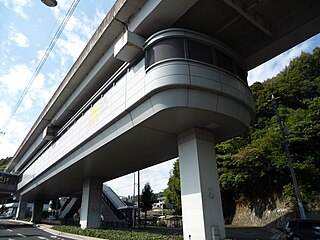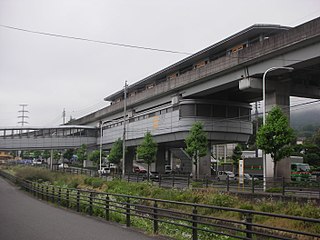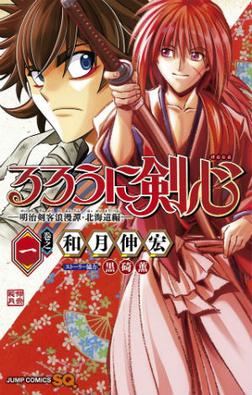
Hiroshima New Transit Line 1, also known as the Astram Line, is a rubber-tired transit system operated by Hiroshima Rapid Transit in Hiroshima, Japan. Astram opened on August 20, 1994, for the 1994 Asian Games in Hiroshima. The line connects central Hiroshima and Hiroshima Big Arch, which was the main stadium of the Asian Games. On March 14, 2015, a new station, Shin-Hakushima, opened to make a new connection between the Astram Line and JR lines.
Hesaka Station is a JR West Geibi Line station located in 2-chōme, Hesaka Sōda, Higashi-ku, Hiroshima, Hiroshima Prefecture, Japan.

Shimo-Gion Station is a JR West Kabe Line station located in Gion, Asaminami-ku, Hiroshima, Hiroshima Prefecture, Japan. The station name on the building uses an older kanji for the "gi", but in most current publications it is listed as 祗 or 祇).

Ōmachi Station is a station operated by the West Japan Railway Company and Hiroshima Rapid Transit. It is located in Ōmachi-higashi, Asaminami-ku, Hiroshima, Hiroshima Prefecture, Japan. The Kabe Line and the Astram Line stop at this station, though they are situated in separate station buildings. An overpass connects the two buildings together.

Gion-shinbashi-kita Station(祇園新橋北駅) is a HRT station on the Astram Line, located in 4-43-28, Nishihara, Asaminami-ku, Hiroshima.

Nakasuji Station is a HRT station on Astram Line, located in 2-6-17, Nakasuji, Asaminami-ku, Hiroshima.

Furuichi Station is a Hiroshima Rapid Transit station on Astram Line, located in Nakasu, Asaminami-ku, Hiroshima.

Bishamondai Station is a HRT station on Astram Line, located in 1-7-45, Bishamondai, Asaminami-ku, Hiroshima.

Kamiyasu Station is a HRT station on Astram Line, located in 2-30-10, Kamiyasu, Asaminami-ku, Hiroshima.

Takatori Station is a HRT station on Astram Line, located in 1-4-28, Takatori-kita, Asaminami-ku, Hiroshima.

Tomo Station is a HRT station on Astram Line, located in 8669-4, Tomo, Numata-cho, Asaminami-ku, Hiroshima.

Ōzuka Station is an HRT station on Astram Line, located in 608-3, Ozuka, Numata-cho, Asaminami-ku, Hiroshima, Japan.

The Disney Resort Line, officially called Dizunī Rizōto Rain-sen, is an automated monorail in Japan, which operates between Maihama Station and the Tokyo Disney Resort. The system is operated by the Maihama Resort Line Company, Ltd., a subsidiary of The Oriental Land Company that owns and operates the resort.

Katsuyuki Kawai is a Japanese politician of the Liberal Democratic Party, a member of the House of Representatives in the Diet. A native of Hiroshima, Hiroshima and graduate of Keio University, he ran unsuccessfully for the House of Representatives in 1993 after serving in the assembly of Hiroshima Prefecture. He ran again three years later and was elected for the first time, but lost the seat in 2000. He was re-elected in 2003. He was the Minister of Justice from 11 September 2019 to 31 October 2019. He stepped down as the Minister of Justice after reports of overpaying workers of Anri Kawai's political campaign beyond the legal limit.

STU48 (Setouchi48) is a Japanese idol group and sister group of AKB48 named after the Setouchi Region. The group had a shipboard theater from 2019 to 2021. It is co-owned by the tourism board of Setouchi Region and is highly involved in their promotional efforts. The group's captain is Azumi Okada and the vice captain is Akari Fukuda.

Rurouni Kenshin: The Hokkaido Arc is a Japanese manga series written and illustrated by Nobuhiro Watsuki. His wife, Kaworu Kurosaki, is credited as a story consultant. It is a direct sequel to Rurouni Kenshin and follows Himura Kenshin and his friends in 1883 Japan as they traverse Hokkaido in search of his father-in-law.
Yasuko Endō was a Japanese model and actress whose idol singer debut was derailed by her suicide at age 17. She is not to be confused with narrator Yasuko Endō (遠藤泰子) or actress Yasuko Endō (遠藤靖子).

"Aldebaran" is a song recorded by Japanese-American singer-songwriter Ai, released on November 1, 2021, by EMI Records and Universal Music Group. The song served as the theme song for the Japanese television drama, Come Come Everybody and subsequently served as the third single from Ai's twelfth studio album, Dream.

Edion Peace Wing Hiroshima (エディオンピースウイング広島) is a football stadium in Hiroshima, Japan, which has a seating capacity of 28,520. It has been the home of Sanfrecce Hiroshima and Sanfrecce Hiroshima Regina since 2024.




















